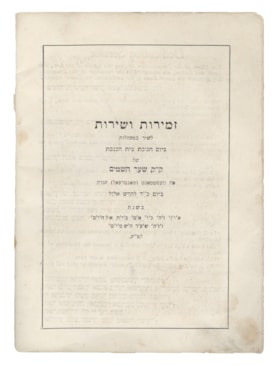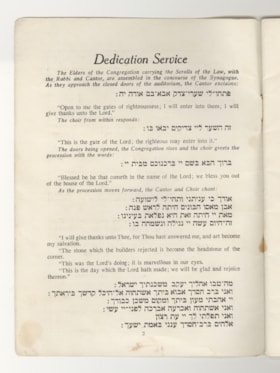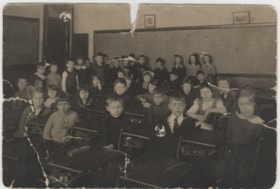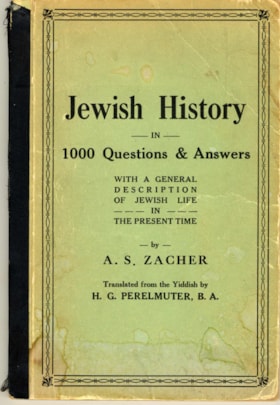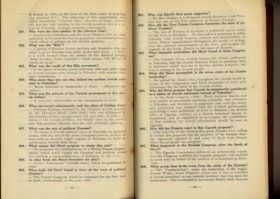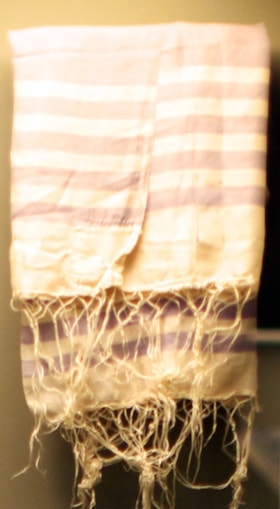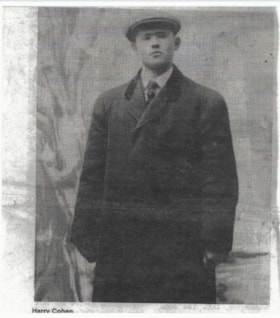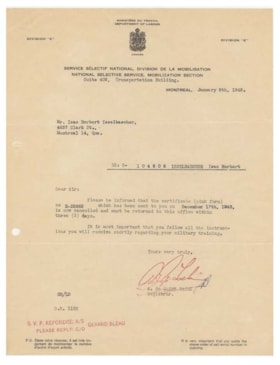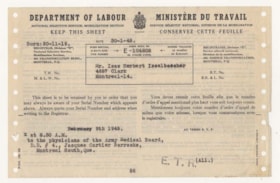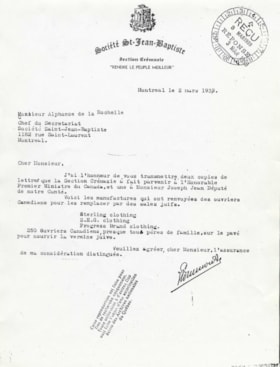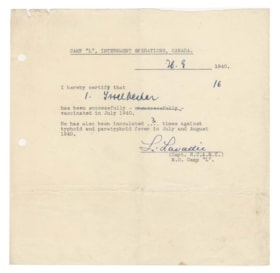Scroll
https://www.cjhn.ca/link/cjhn51282
- Collection
- Montreal Holocaust Museum
- Description Level
- Item
- Material Type
- object
- Physical Description
- Scroll : Paper : Ink : Black, White, Red, Blue, Yellow
- Date
- September 30, 1917
- Collection
- Montreal Holocaust Museum
- Description Level
- Item
- Material Type
- object
- Physical Description
- Scroll : Paper : Ink : Black, White, Red, Blue, Yellow
- Other Title Information
- Documentary Artifact
- Date
- September 30, 1917
- Physical Condition
- Good
- Language
- English
- Notes
- One-sided, with a double vine border. There are illustrations of tank, artillery, jeep, airplane, and naval ship around the border. At the top in the centre is an image of crossed British and UN flags over cannon. Across the bottom in the centre is an open book with vines wrapping around it on either side. Narrative: Scroll presented from Association of Former Concentration Camp Inmates presented to General Price at their first rally commemorating Canadian liberating troops.
- Accession No.
- 2002.44.02
- Name Access
- Zablow, Lou
- Archival / Genealogical
- Archival Descriptions
- Repository
- Montreal Holocaust Museum
Images
Staff of Ideal Upholstering
https://www.cjhn.ca/link/cjhn50154
- Collection
- Montreal Holocaust Museum
- Description Level
- Item
- Material Type
- graphic material
- Physical Description
- Photograph : Paper, cardboard : Black, White ; Ht: 8 in. x W: 10 in.
- Collection
- Montreal Holocaust Museum
- Description Level
- Item
- Material Type
- graphic material
- Physical Description
- Photograph : Paper, cardboard : Black, White ; Ht: 8 in. x W: 10 in.
- Other Title Information
- Documentary Artifact
- Physical Condition
- Good
- Language
- English
- Notes
- 12 people, eleven men, one women. Taken indoors, in a woprkshop. Adolph Singer (donor's father) is seen on the far left. Narrative: Adolph Singer ran the store with his three brothers: David, Hyman & Isaac
- Accession No.
- 1996.32.226
- Name Access
- Shenkman, Shirley
- Archival / Genealogical
- Archival Descriptions
- Repository
- Montreal Holocaust Museum
Images
Staff of Ideal Upholstering
https://www.cjhn.ca/link/cjhn50158
- Collection
- Montreal Holocaust Museum
- Description Level
- Item
- Material Type
- graphic material
- Physical Description
- Photograph : Paper, cardboard : Black, White, Grey ; Ht: 8 in. x W: 10 in.
- Collection
- Montreal Holocaust Museum
- Description Level
- Item
- Material Type
- graphic material
- Physical Description
- Photograph : Paper, cardboard : Black, White, Grey ; Ht: 8 in. x W: 10 in.
- Other Title Information
- Documentary Artifact
- Physical Condition
- Good
- Notes
- Framed, b&w group photograph, outdoors. Employees of Ideal Upholstering are standing outside with Adolph Singer (donor’s father) at far right. Group is made mainly of men and of five women in front. Narrative: Adolph Singer ran the business with his three brothers: David, Hyman & Isaac
- Accession No.
- 1996.32.227
- Name Access
- Shenkman, Shirley
- Archival / Genealogical
- Archival Descriptions
- Repository
- Montreal Holocaust Museum
Images
Booklet, Dedication
https://www.cjhn.ca/link/cjhn59940
- Collection
- Montreal Holocaust Museum
- Description Level
- Item
- Material Type
- textual record
- Physical Description
- Booklet, Dedication : paper : Printed ; Ht: 20,8 cm x W: 15,1 cm
- Date
- September 17, 1922
- Collection
- Montreal Holocaust Museum
- Description Level
- Item
- Material Type
- textual record
- Physical Description
- Booklet, Dedication : paper : Printed ; Ht: 20,8 cm x W: 15,1 cm
- Other Title Information
- Documentary Artifact
- Date
- September 17, 1922
- Physical Condition
- Good
- Notes
- Service booklet, thirty pages long, only printed pages are numbered, contains texts, prayers, and photographs. Program of the dedication services for the Shaar Hashomayim synagogue in Montreal.
- Accession No.
- 2010.19.03
- Name Access
- Bernstein, Marc
- Archival / Genealogical
- Archival Descriptions
- Repository
- Montreal Holocaust Museum
Images
Bertram Ellison 1st Grade class, Queens School Montreal
https://www.cjhn.ca/link/cjhn59993
- Collection
- Montreal Holocaust Museum
- Description Level
- Item
- Material Type
- graphic material
- Physical Description
- Photograph : Paper : Black, White, Green ; Ht: 10 cm x W: 15 cm
- Date
- 1923
- Collection
- Montreal Holocaust Museum
- Description Level
- Item
- Material Type
- graphic material
- Physical Description
- Photograph : Paper : Black, White, Green ; Ht: 10 cm x W: 15 cm
- Other Title Information
- Documentary Artifact
- Date
- 1923
- Physical Condition
- Good
- Language
- English
- Notes
- Indoors. Group of boys and girls, in the foreground the children are sitting at desks, and in the background they are standing in front of a chalk board which has math, and grammar on it. Narrative: Bertram Ellison (donor's uncle) was born on March 19, 1909 in Montreal. He was born into a Jewish family, and was an insurance broker before the war. He joined the Canadian Army on June 5th 1941 as a 2nd Lieutenant. Between 1941 and 1945 he rose to the rank of major, and received 6 medals, including the Most Excellent Order of the British Empire which he received on December 18t 1945. He was part of the 21st Army Group, which was formed on July 9th 1943 by the 2nd British and 1st Canadian Army for a North Western European Invasion. While apart of the 21st Army Group, he saw Bergen-Belsen. Bertram Ellison sailed home on the RMS Queen Elisabeth on December 3rd – 9th 1945.
- Accession No.
- 2013.01.02
- Name Access
- Berman, Marilyn
- Archival / Genealogical
- Archival Descriptions
- Repository
- Montreal Holocaust Museum
Images
Why We Should Oppose the Jew
https://www.cjhn.ca/link/cjhn50172
- Collection
- Montreal Holocaust Museum
- Description Level
- Item
- Material Type
- textual record
- Physical Description
- Booklet : Paper : Bound : Black, White ; Ht: 9 in. x W: 6 in.
- Date
- 1935
- Collection
- Montreal Holocaust Museum
- Description Level
- Item
- Material Type
- textual record
- Physical Description
- Booklet : Paper : Bound : Black, White ; Ht: 9 in. x W: 6 in.
- Other Title Information
- Documentary Artifact
- Date
- 1935
- Creator
- 0
- Physical Condition
- fragile
- Language
- English
- Notes
- 17 pages, in paragraph form, stapled along the edge Narrative: Antisemitic propaganda essay written by Dr. Lalanne, member of the Native Sons of Canada, based on a lecture delivered on September 15th, 1935 under the auspices of the Native Sons of Canada.
- Accession No.
- 1997.39.11
- Name Access
- Flanders (Rome), Tibey
- Archival / Genealogical
- Archival Descriptions
- Repository
- Montreal Holocaust Museum
Images
La clé du mystère
https://www.cjhn.ca/link/cjhn75117
- Collection
- Montreal Holocaust Museum
- Description Level
- Item
- Material Type
- textual record
- Physical Description
- Booklet : Paper : Printed : Ink : beige, black ; Ht: 17 in. x W: 11,5 in.
- Date
- [ca. 1938]
- Collection
- Montreal Holocaust Museum
- Description Level
- Item
- Material Type
- textual record
- Physical Description
- Booklet : Paper : Printed : Ink : beige, black ; Ht: 17 in. x W: 11,5 in.
- Other Title Information
- Documentary Artifact
- Date
- [ca. 1938]
- Physical Condition
- Poor
- Language
- English
- French
- Notes
- 32 pages, paper cover. Folded once horizontally. Title on cover in large letters, with an image of a key instead of the word. Price of 5 cents listed at top right corner. Narrative: The Clé du Mystère (Key of the Mystery) was an anonymous pamphlet, distributed in Canada by the Montreal Anti-Communist Committee (Comité Anticommuniste de Montréal). A virulently antisemitic publication based on Medieval superstitions about Jews as bloodthirsty world conspirators, it was distributed first in Switzerland and other parts of Europe, before being printed and distributed in Montreal. The pamphlet presents a collection of quotes and so-called evidence of the presence of a worldwide Jewish conspiracy, with subtitles such as "Communism means Jewish conquest" and “Why the Jews cannot be Canadian”.
- Accession No.
- 2011X.41.06
- Name Access
- Orenstein, Benjamin
- Archival / Genealogical
- Archival Descriptions
- Repository
- Montreal Holocaust Museum
Images
Jewish History in 1000 Questions & Answers
https://www.cjhn.ca/link/cjhn47819
- Collection
- Montreal Holocaust Museum
- Description Level
- Item
- Material Type
- textual record
- Physical Description
- Book : printed, bound : beige, green, black ; Ht: 22,5 cm x W: 15,2 cm
- Date
- September 1937
- Collection
- Montreal Holocaust Museum
- Description Level
- Item
- Material Type
- textual record
- Physical Description
- Book : printed, bound : beige, green, black ; Ht: 22,5 cm x W: 15,2 cm
- Other Title Information
- Documentary Artifact
- Date
- September 1937
- Creator
- 0
- Physical Condition
- Poor
- Language
- English
- Notes
- 107 pages, softcover, paper, bound with staples and black fabric tape. The front cover is green, outlined with a decorative border. Inside pages are beige, consisting of text, whicih has been broken down into chapter and article numbers. Question & Answer format the book explains basic history of the Jewish civilization.
- Accession No.
- 2001.53.01
- Name Access
- Grant, Raymonde
- Archival / Genealogical
- Archival Descriptions
- Repository
- Montreal Holocaust Museum
Images
Letter
https://www.cjhn.ca/link/cjhn75116
- Collection
- Montreal Holocaust Museum
- Description Level
- Item
- Material Type
- textual record
- Physical Description
- Letter : Paper : Typed : Ink : B&W ; Ht: 11 in. x W: 8,5 in.
- Date
- November 18, 1938
- Collection
- Montreal Holocaust Museum
- Description Level
- Item
- Material Type
- textual record
- Physical Description
- Letter : Paper : Typed : Ink : B&W ; Ht: 11 in. x W: 8,5 in.
- Other Title Information
- Documentary Artifact
- Date
- November 18, 1938
- Physical Condition
- Good
- Language
- French
- Notes
- 1 page, single-sided. Letter signed by the head of the secretariat of the Montreal branch of the Saint-Jean-Baptiste Society. The letter informs members that the National Action League had sent a letter to Canadian Prime Minister Mackenzie King opposing the opening of Canadian borders to Jews from Central Europe. Letter further summarizes the letter to King, remarking that while it deplores the sad situation for Jews in Europe, if Neville Chamberlain decided to pay for European peace with Czechoslovakia, Canada should not have to pay a part of the price for solving the Jewish problem, for which the Jews are undoubtedly responsible. Narrative: The Saint-Jean-Baptiste Society (Société Saint-Jean-Baptiste) was founded on June 24, 1834 to promote French-Canadian interests, preserve French language and culture, and protect Catholicism. It is still in existence today, though it has shifted to an espousal of the Quebec separatist movement. The National Action League (Ligue D`Action Nationale) was founded as a Catholic, nationalist organization on March 11, 1903. It later shifted to a secular, separatist stance and is still in existence today. In the 1930s, both organizations vehemently opposed Jewish immigration to Quebec.
- Accession No.
- 2011X.67.01
- Name Access
- Archives nationales du Quebec
- Archival / Genealogical
- Archival Descriptions
- Repository
- Montreal Holocaust Museum
Images
Photograph
https://www.cjhn.ca/link/cjhn47820
- Collection
- Montreal Holocaust Museum
- Description Level
- Item
- Material Type
- graphic material
- Physical Description
- Photograph : paper : photographed, printed, cut, screwed : ink : black, white, silver, beige
- Date
- 1939-1945
- Collection
- Montreal Holocaust Museum
- Description Level
- Item
- Material Type
- graphic material
- Physical Description
- Photograph : paper : photographed, printed, cut, screwed : ink : black, white, silver, beige
- Other Title Information
- Documentary Artifact
- Date
- 1939-1945
- Physical Condition
- Good
- Notes
- B&w photo of a sitting man in Canadian Forces uniform and cap; he has a mustache, glasses and is holding swagger stick; his cap insignia and patches indicate he was a corporal in the CF Provost Corps C; surrounded by a beige window mat. Housed in a shiny metal frame; glass glazing. The frame is held together with metal brackets on the reverse; attached to each side are screw hole hangers, connected with metal wire.
- Accession No.
- 2001.02.02
- Name Access
- Selig, Roslyn
- Archival / Genealogical
- Archival Descriptions
- Repository
- Montreal Holocaust Museum
Images
Prayer shawl
https://www.cjhn.ca/link/cjhn51279
- Collection
- Montreal Holocaust Museum
- Description Level
- Item
- Material Type
- object
- Physical Description
- Prayer shawl : Sewn : Blue, White ; Ht: 25,5 in. x W: 67 in.
- Date
- [Prior to 1939]
- Collection
- Montreal Holocaust Museum
- Description Level
- Item
- Material Type
- object
- Physical Description
- Prayer shawl : Sewn : Blue, White ; Ht: 25,5 in. x W: 67 in.
- Other Title Information
- Ceremonial Artifact
- Date
- [Prior to 1939]
- Physical Condition
- fragile
- Notes
- Horizontal blue stripes and tassels on either end. Narrative: This prayer shawl was used in Roy street synagogue in Montreal before the war by Harry Cohen. Harry Cohen was born in Poland and had immigrated to Montreal. In the summer of 1939, he returned to Poland to take care of family affairs (presumably following his mother's death) leaving his four children behind. His wife had already passed away. The war broke out and Harry was unable to leave Poland. He was hiding with a Christian family but was finally deported to Auschwitz. He was presumably killed in Auschwitz, which would make him the only Canadian citizen known to have been murdered in the camp. The prayer shawl was returned to Harry Cohen's children in Septembe or October 1945 by a Polish woman who claimed to have hidden Harry before his deportation.along the shwal were also sent Harry's prayer book and unsigned traveller’s cheques.
- Accession No.
- 2011X.101.01
- Name Access
- Cohen, Manuel (Manny)
- Archival / Genealogical
- Archival Descriptions
- Repository
- Montreal Holocaust Museum
Images
Harry Cohen
https://www.cjhn.ca/link/cjhn51329
- Collection
- Montreal Holocaust Museum
- Description Level
- Item
- Material Type
- graphic material
- Physical Description
- Photograph : Paper : Black, White
- Date
- [Prior to 1939]
- Collection
- Montreal Holocaust Museum
- Description Level
- Item
- Material Type
- graphic material
- Physical Description
- Photograph : Paper : Black, White
- Other Title Information
- Documentary Artifact
- Date
- [Prior to 1939]
- Physical Condition
- Excellent
- Notes
- B&W. Outdoors portrait of Harry Cohen wearing a 3 piece suit with a tie and a button on his lapel. Photographer's stamp on bottom right corner. Narrative: Harry Cohen was born in Poland and had immigrated to Montreal. In the summer of 1939, he returned to Poland to take care of family affairs (presumabley following his mother's death) leaving his four children behind. His wife had already passed away. The war broke out and Harry was unable to leave Poland. HE was hiding with a Christian family but was finally deported to Auschwitz. He was presumably killed in Auschwitz, which would make him the only Canadian citizen known to have been murdered in the camp. The prayer shawl was returned to Harry Cohen's children in Septembe or October 1945 by a Polish woman who claimed to have hidden Harry before his deportation.along the shwal were also sent Harry's prayer book and unsigned traveller’s cheques.
- Accession No.
- 2011X.100.01
- Name Access
- Cohen, Manuel (Manny)
- Archival / Genealogical
- Archival Descriptions
- Repository
- Montreal Holocaust Museum
Images
Harry Cohen
https://www.cjhn.ca/link/cjhn51333
- Collection
- Montreal Holocaust Museum
- Description Level
- Item
- Material Type
- graphic material
- Physical Description
- Photograph : Paper : Black, White
- Date
- [Prior to 1939]
- Collection
- Montreal Holocaust Museum
- Description Level
- Item
- Material Type
- graphic material
- Physical Description
- Photograph : Paper : Black, White
- Other Title Information
- Documentary Artifact
- Date
- [Prior to 1939]
- Physical Condition
- Good
- Notes
- B&w, outdoors. Henry Cohen in coat and tie, and flat hat. Narrative: Harry Cohen was born in Poland and had immigrated to Montreal. In the summer of 1939, he returned to Poland to take care of family affairs (presumabley following his mother's death) leaving his four children behind. His wife had already passed away. The war broke out and Harry was unable to leave Poland. HE was hiding with a Christian family but was finally deported to Auschwitz. He was presumably killed in Auschwitz, which would make him the only Canadian citizen known to have been murdered in the camp. The prayer shawl was returned to Harry Cohen's children in Septembe or October 1945 by a Polish woman who claimed to have hidden Harry before his deportation.along the shwal were also sent Harry's prayer book and unsigned traveller’s cheques.
- Accession No.
- 2011X.100.04
- Name Access
- Cohen, Manuel (Manny)
- Archival / Genealogical
- Archival Descriptions
- Repository
- Montreal Holocaust Museum
Images
Letter
https://www.cjhn.ca/link/cjhn59425
- Collection
- Montreal Holocaust Museum
- Description Level
- Item
- Material Type
- textual record
- Physical Description
- Letter : Paper : Typewritten : Ink : Beige, black, red ; Ht: 27 cm x W: 22 cm
- Date
- 1939-January 05, 1945
- Collection
- Montreal Holocaust Museum
- Description Level
- Item
- Material Type
- textual record
- Physical Description
- Letter : Paper : Typewritten : Ink : Beige, black, red ; Ht: 27 cm x W: 22 cm
- Other Title Information
- Documentary Artifact
- Date
- 1939-January 05, 1945
- Physical Condition
- Good
- Language
- English
- Notes
- Page creased twice horizontally, two holes punched on left edge, Department of Labour National Selective Service Mobilization Section letterhead. From the Department of Labour to Isaac Herbert Isselbaecher regarding his military training. Narrative: Isaac Herbert Isselbacher was born 1919-11-20 in Isselbach, Germany. His brother was Helmut Isselbacher, born 1921-12-20. Their father was Jacob Isselbacher, born 1883-08-05. They had an uncle and aunt, David and Betty Loewenstein, who lived in New York City with their two children. Isaac left Germany on 1939-07-29, hoping to join his relatives in NYC. He only had the time to get to London, England before the war broke out and started working in a factory. He was arrested at his workplace as an ‘enemy alien’ and sent to Canada for internment in 1940. Isaac was interned in Camp N in Sherbrooke, Quebec. He was drafted into the Works Program Division for woodworking and net-making. In 1940, he received a last letter from his parents which suggested their imminent deportation. After his release, circa November 1942, Isaac worked as a locksmith. He married Fanny Azeff on 1943-12-26 at the Bnai Jacob synagogue in Montreal. Fanny was born on 1921-12-23 in Canada, the daughter of Mr. and Mrs. Harry Azeff. Isaac was naturalized as a Canadian citizen on 1946-06-08. Fanny was naturalized on 1946-08-30 (she had lost her citizenship by marrying Isaac). Isaac’s brother, Helmut Isselbacher, was deported with Transport XXII A from Dossin casern in Mechelen (Malines), Belgium to Auschwitz Birkenau, Poland on 1943-09-20. Of the 2,450 people on the transport, 100 men were selected to work –including Helmut- and the remainder prisoners were gassed. Helmut was made to work as a welder, and was soon fitting new pipes for the gas chamber. He suffered a nervous breakdown as a result. As he was a valued welder, he was transferred to a labour camp in Upper Silesia (Poland) where he remained for two years. As the Russian army advanced, the 6,000 prisoners of this camp were evacuated by train. Helmut remembered being forced to march as the other prisoners died from exhaustion. When liberation was announced, the survivors travelled by ship from Luebeck, Germany, to Sweden with the aid of the Red Cross. After recovery, Helmut decided to remain in Sweden as a welder. Upon learning of his brother’s survival, Helmut travelled to New York in April 1946 to meet with him and their Loewenstein relatives. Afterwards, Helmut travelled to Canada bringing with him a washing machine and bras as late wedding presents for his brother and Fanny. By 1946-08-12, their parents were presumed dead and the two sons inquired into their estate. They received a deed for the land and travelled to the estate to discover that the current owner of their house was their old maid and her son had become the town mayor. Various disputes arose with the current ‘owners’ who believed the Isselbacher family dead. Isaac wished to discuss a settlement, but the mayor’s mother –not realizing Fanny understood German- called the neighbours at work to warn them not to come home as the Isselbacher sons had resurfaced. Payment for the land had reportedly been sent to Israel, though no documentation could be provided.
- Accession No.
- 1999.1.331
- Name Access
- Issley, Jason
- Archival / Genealogical
- Archival Descriptions
- Repository
- Montreal Holocaust Museum
Images
Medical certificate
https://www.cjhn.ca/link/cjhn59472
- Collection
- Montreal Holocaust Museum
- Description Level
- Item
- Material Type
- textual record
- Physical Description
- Medical certificate : Paper : Printed : Ink : Beige, black ; Ht: 14 cm x W: 22 cm
- Date
- 1939-February 09, 1945
- Collection
- Montreal Holocaust Museum
- Description Level
- Item
- Material Type
- textual record
- Physical Description
- Medical certificate : Paper : Printed : Ink : Beige, black ; Ht: 14 cm x W: 22 cm
- Other Title Information
- Documentary Artifact
- Date
- 1939-February 09, 1945
- Physical Condition
- Good
- Language
- English
- French
- Notes
- Page with line of holes punched on sides, Department of Labour letterhead, printed sheet with typewritten details added, Instructions on back. Certificate of Department of Labour summoning Herbert Isselbacher to a medical exam. He was officially released from internment and was required to have a medical check before being drafted into the Armed Forces labour division. Narrative: Isaac Herbert Isselbacher was born 1919-11-20 in Isselbach, Germany. His brother was Helmut Isselbacher, born 1921-12-20. Their father was Jacob Isselbacher, born 1883-08-05. They had an uncle and aunt, David and Betty Loewenstein, who lived in New York City with their two children. Isaac left Germany on 1939-07-29, hoping to join his relatives in NYC. He only had the time to get to London, England before the war broke out and started working in a factory. He was arrested at his workplace as an ‘enemy alien’ and sent to Canada for internment in 1940. Isaac was interned in Camp N in Sherbrooke, Quebec. He was drafted into the Works Program Division for woodworking and net-making. In 1940, he received a last letter from his parents which suggested their imminent deportation. After his release, circa November 1942, Isaac worked as a locksmith. He married Fanny Azeff on 1943-12-26 at the Bnai Jacob synagogue in Montreal. Fanny was born on 1921-12-23 in Canada, the daughter of Mr. and Mrs. Harry Azeff. Isaac was naturalized as a Canadian citizen on 1946-06-08. Fanny was naturalized on 1946-08-30 (she had lost her citizenship by marrying Isaac). Isaac’s brother, Helmut Isselbacher, was deported with Transport XXII A from Dossin casern in Mechelen (Malines), Belgium to Auschwitz Birkenau, Poland on 1943-09-20. Of the 2,450 people on the transport, 100 men were selected to work –including Helmut- and the remainder prisoners were gassed. Helmut was made to work as a welder, and was soon fitting new pipes for the gas chamber. He suffered a nervous breakdown as a result. As he was a valued welder, he was transferred to a labour camp in Upper Silesia (Poland) where he remained for two years. As the Russian army advanced, the 6,000 prisoners of this camp were evacuated by train. Helmut remembered being forced to march as the other prisoners died from exhaustion. When liberation was announced, the survivors travelled by ship from Luebeck, Germany, to Sweden with the aid of the Red Cross. After recovery, Helmut decided to remain in Sweden as a welder. Upon learning of his brother’s survival, Helmut travelled to New York in April 1946 to meet with him and their Loewenstein relatives. Afterwards, Helmut travelled to Canada bringing with him a washing machine and bras as late wedding presents for his brother and Fanny. By 1946-08-12, their parents were presumed dead and the two sons inquired into their estate. They received a deed for the land and travelled to the estate to discover that the current owner of their house was their old maid and her son had become the town mayor. Various disputes arose with the current ‘owners’ who believed the Isselbacher family dead. Isaac wished to discuss a settlement, but the mayor’s mother –not realizing Fanny understood German- called the neighbours at work to warn them not to come home as the Isselbacher sons had resurfaced. Payment for the land had reportedly been sent to Israel, though no documentation could be provided.
- Accession No.
- 1999.1.99
- Name Access
- Issley, Jason
- Archival / Genealogical
- Archival Descriptions
- Repository
- Montreal Holocaust Museum
Images
Greeting card
https://www.cjhn.ca/link/cjhn59704
- Collection
- Montreal Holocaust Museum
- Description Level
- Item
- Material Type
- textual record
- Physical Description
- Greeting card : Cardstock : Printed : Ink : Beige, black ; Ht: 6 cm x W: 9 cm
- Date
- 1939-1944
- Collection
- Montreal Holocaust Museum
- Description Level
- Item
- Material Type
- textual record
- Physical Description
- Greeting card : Cardstock : Printed : Ink : Beige, black ; Ht: 6 cm x W: 9 cm
- Other Title Information
- Documentary Artifact
- Date
- 1939-1944
- Physical Condition
- Good
- Language
- English
- Notes
- Small card with two holes punched on top edge, stock note printed in calligraphic script. Thank You card from Mr. and Mrs. H. Rosenberg to Isaac and Fanny Isselbacher for attending their marriage. Narrative: Isaac Herbert Isselbacher was born 1919-11-20 in Isselbach, Germany. His brother was Helmut Isselbacher, born 1921-12-20. Their father was Jacob Isselbacher, born 1883-08-05. They had an uncle and aunt, David and Betty Loewenstein, who lived in New York City with their two children. Isaac left Germany on 1939-07-29, hoping to join his relatives in NYC. He only had the time to get to London, England before the war broke out and started working in a factory. He was arrested at his workplace as an ‘enemy alien’ and sent to Canada for internment in 1940. Isaac was interned in Camp N in Sherbrooke, Quebec. He was drafted into the Works Program Division for woodworking and net-making. In 1940, he received a last letter from his parents which suggested their imminent deportation. After his release, circa November 1942, Isaac worked as a locksmith. He married Fanny Azeff on 1943-12-26 at the Bnai Jacob synagogue in Montreal. Fanny was born on 1921-12-23 in Canada, the daughter of Mr. and Mrs. Harry Azeff. Isaac was naturalized as a Canadian citizen on 1946-06-08. Fanny was naturalized on 1946-08-30 (she had lost her citizenship by marrying Isaac). Isaac’s brother, Helmut Isselbacher, was deported with Transport XXII A from Dossin casern in Mechelen (Malines), Belgium to Auschwitz Birkenau, Poland on 1943-09-20. Of the 2,450 people on the transport, 100 men were selected to work –including Helmut- and the remainder prisoners were gassed. Helmut was made to work as a welder, and was soon fitting new pipes for the gas chamber. He suffered a nervous breakdown as a result. As he was a valued welder, he was transferred to a labour camp in Upper Silesia (Poland) where he remained for two years. As the Russian army advanced, the 6,000 prisoners of this camp were evacuated by train. Helmut remembered being forced to march as the other prisoners died from exhaustion. When liberation was announced, the survivors travelled by ship from Luebeck, Germany, to Sweden with the aid of the Red Cross. After recovery, Helmut decided to remain in Sweden as a welder. Upon learning of his brother’s survival, Helmut travelled to New York in April 1946 to meet with him and their Loewenstein relatives. Afterwards, Helmut travelled to Canada bringing with him a washing machine and bras as late wedding presents for his brother and Fanny. By 1946-08-12, their parents were presumed dead and the two sons inquired into their estate. They received a deed for the land and travelled to the estate to discover that the current owner of their house was their old maid and her son had become the town mayor. Various disputes arose with the current ‘owners’ who believed the Isselbacher family dead. Isaac wished to discuss a settlement, but the mayor’s mother –not realizing Fanny understood German- called the neighbours at work to warn them not to come home as the Isselbacher sons had resurfaced. Payment for the land had reportedly been sent to Israel, though no documentation could be provided.
- Accession No.
- 1999.1.1074
- Name Access
- Issley, Jason
- Archival / Genealogical
- Archival Descriptions
- Repository
- Montreal Holocaust Museum
Images
Bookmark
https://www.cjhn.ca/link/cjhn59950
- Collection
- Montreal Holocaust Museum
- Description Level
- Item
- Material Type
- object
- Physical Description
- Bookmark : cast (moulded) : Red, Yellow, Blue, Bronze
- Date
- 1939
- Collection
- Montreal Holocaust Museum
- Description Level
- Item
- Material Type
- object
- Physical Description
- Bookmark : cast (moulded) : Red, Yellow, Blue, Bronze
- Other Title Information
- Written Communication T&E
- Date
- 1939
- Physical Condition
- Good
- Language
- English
- Notes
- The top of the bookmark has crest with a single maple leaf in the middle. Underneath, is a circular piece with raised effigies of King George VI and Queen Elizabeth II. The bottom is a rounded triangle, with a recessed area in the middle, which holds a page. The box is rectangular and has two illustrations of the Royal Crown along the left side. Narrative: Gerhart Adolf Maass (Hambourg 1918-Montreal 2009), also known as “Gerry”, was the youngest son of Adolf Maass and Käthe Elsbach. In 1935, summoned by his parents to leave Germany, Gerhart had no other idea in mind than coming to Canada. He was well supported by a distant cousin of his father, Rudolf van der Walde, who owned an import business in Hamburg with several subsidiaries around the world. The idea was that once hired, Gerhart could be transferred to the Canadian office of the company. After having worked in Sweden for the Swedish subsidiary, and only after obtaining permission to come to Canada, Gerhart had to return to Germany in 1938 in order to renew his passport and seek a visa at the Canadian Consulate in Hamburg. Gerhart came to Canada in November 1938 and tried to help his parents out of Germany, but in vain. He enlisted in the Canadian Army in 1942 and in 1944 received his certificate of naturalization, which allowed him to be accepted into the Secret intelligence services. Gerhart served in France, Holland and Germany where he was stationed in the town of Oldenburg, in the British Zone and became the personal assistant of Major Morris DF. He returned to Herford at the end of the war, and recovered the family business (Elsbach co.) which had been confiscated by NSDAP authorities in 1938. After Liberation, he accessed the archives of the Gestapo in Hamburg and found hundreds of documents relating to his family. He learned that after being sent to Theresienstadt ghetto, his parents were deported and murdered in Auschwitz in 1944. Gerhart was the last Canadian soldier stationed in Oldenburg and was given the Canadian flag hanging over the entrance of the camp; he later donated it to the Canadian War Museum. Gerhart returned to Canada in September 1946 and settled in Montreal.
- Accession No.
- 2010.07.12
- Name Access
- Maass, Joan
- Archival / Genealogical
- Archival Descriptions
- Repository
- Montreal Holocaust Museum
Images
Letter
https://www.cjhn.ca/link/cjhn75147
- Collection
- Montreal Holocaust Museum
- Description Level
- Item
- Material Type
- textual record
- Physical Description
- Letter : Paper : Typed : Ink : B&W ; Ht: 10,5 in. x W: 8 in.
- Date
- March 2, 1939
- Collection
- Montreal Holocaust Museum
- Description Level
- Item
- Material Type
- textual record
- Physical Description
- Letter : Paper : Typed : Ink : B&W ; Ht: 10,5 in. x W: 8 in.
- Other Title Information
- Documentary Artifact
- Date
- March 2, 1939
- Physical Condition
- Good
- Language
- French
- Notes
- 1 page, single-sided. Typed on letterhead. Letter dated March 2, 1939, addressed to Alphonse de la Rochelle, head of Secretariat of Montreal section of Saint-Jean-Baptiste Society, from the Crémazie section of the organization. Letter refers to accompanying copies of correspondence sent to the Canadian Prime Minister and to Joseph Jean, county deputy. Letter lists 3 manufacturing companies that fired Canadian workers and replaced them with "dirty Jews". Letter states that 250 Canadian workers, nearly all heads of households, have been put on the street to feed the "Jewish vermin". Narrative: The Saint-Jean-Baptiste Society (Société Saint-Jean-Baptiste) was founded on June 24, 1834 to promote French-Canadian interests, preserve French language and culture, and protect Catholicism. It is still in existence today, though it has shifted to an espousal of the Quebec separatist movement. In the 1930s, it vehemently opposed Jewish immigration to Quebec.
- Accession No.
- 2011X.67.02
- Name Access
- Archives nationales du Quebec
- Archival / Genealogical
- Archival Descriptions
- Repository
- Montreal Holocaust Museum
Images
Manuscript
https://www.cjhn.ca/link/cjhn59443
- Collection
- Montreal Holocaust Museum
- Description Level
- Item
- Material Type
- textual record
- Physical Description
- Manuscript : Wax Paper : Handwritten : Ink : Beige, black ; Ht: 21 incm. x W: 15 incm.
- Date
- 1940-1942
- Collection
- Montreal Holocaust Museum
- Description Level
- Item
- Material Type
- textual record
- Physical Description
- Manuscript : Wax Paper : Handwritten : Ink : Beige, black ; Ht: 21 incm. x W: 15 incm.
- Other Title Information
- Documentary Artifact
- Date
- 1940-1942
- Physical Condition
- Good
- Language
- English
- German
- Notes
- Page torn on both sides, two holes punched on left edge. List of Missing Articles of Luggage written by Mr. Isselbaecher
- Accession No.
- 1999.1.642
- Name Access
- Issley, Jason
- Archival / Genealogical
- Archival Descriptions
- Repository
- Montreal Holocaust Museum
Images
Medical certificate
https://www.cjhn.ca/link/cjhn59448
- Collection
- Montreal Holocaust Museum
- Description Level
- Item
- Material Type
- textual record
- Physical Description
- Medical certificate : Paper : Typewritten : Ink : Beige, black ; Ht: 20 cm x W: 22 cm
- Date
- September 26, 1940
- Collection
- Montreal Holocaust Museum
- Description Level
- Item
- Material Type
- textual record
- Physical Description
- Medical certificate : Paper : Typewritten : Ink : Beige, black ; Ht: 20 cm x W: 22 cm
- Other Title Information
- Documentary Artifact
- Date
- September 26, 1940
- Physical Condition
- Good
- Language
- English
- Notes
- Page with two holes punched on left edge, single-sided stock for with additions added by hand. This is an Inoculation Certificate from the Camp L Internment operations in Canada. Mr. Isselbaecher was interned in England and sent to Canada as a potential enemy alien. Narrative: Isaac Herbert Isselbacher was born 1919-11-20 in Isselbach, Germany. His brother was Helmut Isselbacher, born 1921-12-20. Their father was Jacob Isselbacher, born 1883-08-05. They had an uncle and aunt, David and Betty Loewenstein, who lived in New York City with their two children. Isaac left Germany on 1939-07-29, hoping to join his relatives in NYC. He only had the time to get to London, England before the war broke out and started working in a factory. He was arrested at his workplace as an ‘enemy alien’ and sent to Canada for internment in 1940. Isaac was interned in Camp N in Sherbrooke, Quebec. He was drafted into the Works Program Division for woodworking and net-making. In 1940, he received a last letter from his parents which suggested their imminent deportation. After his release, circa November 1942, Isaac worked as a locksmith. He married Fanny Azeff on 1943-12-26 at the Bnai Jacob synagogue in Montreal. Fanny was born on 1921-12-23 in Canada, the daughter of Mr. and Mrs. Harry Azeff. Isaac was naturalized as a Canadian citizen on 1946-06-08. Fanny was naturalized on 1946-08-30 (she had lost her citizenship by marrying Isaac). Isaac’s brother, Helmut Isselbacher, was deported with Transport XXII A from Dossin casern in Mechelen (Malines), Belgium to Auschwitz Birkenau, Poland on 1943-09-20. Of the 2,450 people on the transport, 100 men were selected to work –including Helmut- and the remaining prisoners were gassed. Helmut was made to work as a welder, and was soon fitting new pipes for the gas chamber. He suffered a nervous breakdown as a result. As he was a valued welder, he was transferred to a labour camp in Upper Silesia (Poland) where he remained for two years. As the Russian army advanced, the 6,000 prisoners of this camp were evacuated by train. Helmut remembered being forced to march as the other prisoners died from exhaustion. When liberation was announced, the survivors travelled by ship from Luebeck, Germany, to Sweden with the aid of the Red Cross. After recovery, Helmut decided to remain in Sweden as a welder. Upon learning of his brother’s survival, Helmut travelled to New York in April 1946 to meet with him and their Loewenstein relatives. Afterwards, Helmut travelled to Canada bringing with him a washing machine and bras as late wedding presents for his brother and Fanny. By 1946-08-12, their parents were presumed dead and the two sons inquired into their estate. They received a deed for the land and travelled to the estate to discover that the current owner of their house was their old maid and her son had become the town mayor. Various disputes arose with the current ‘owners’ who believed the Isselbacher family dead. Isaac wished to discuss a settlement, but the mayor’s mother –not realizing Fanny understood German- called the neighbours at work to warn them not to come home as the Isselbacher sons had resurfaced. Payment for the land had reportedly been sent to Israel, though no documentation could be provided.
- Accession No.
- 1999.1.68
- Name Access
- Issley, Jason
- Archival / Genealogical
- Archival Descriptions
- Repository
- Montreal Holocaust Museum
Images
{{ server.message }}




